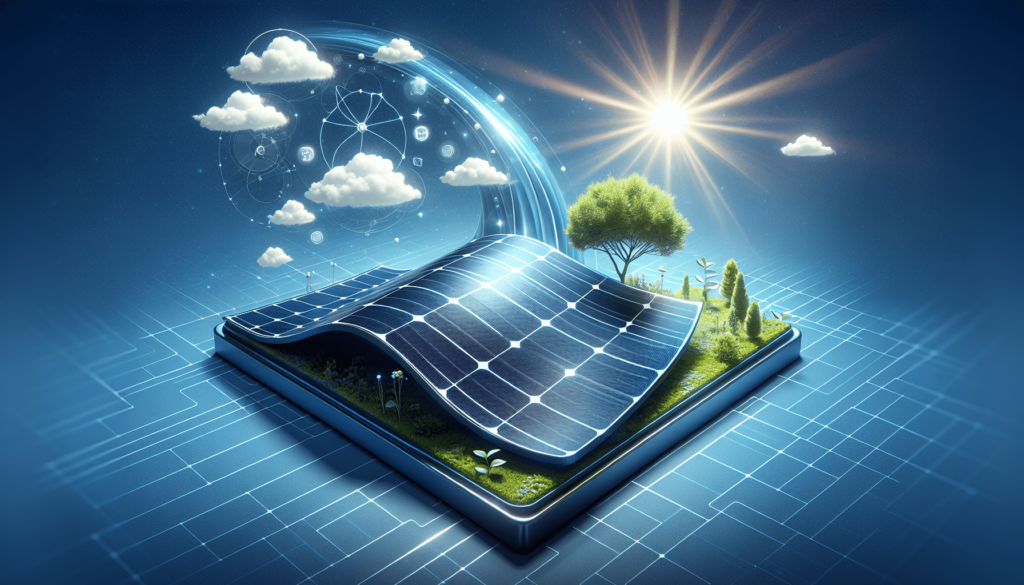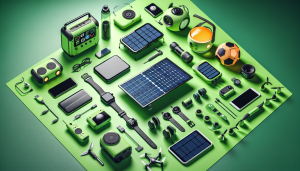Thin-film solar panels are a game-changer in the world of renewable energy, revolutionizing the way we harness and utilize the power of the sun. Unlike traditional bulky solar panels, thin-film solar panels are lightweight, flexible, and incredibly efficient at converting sunlight into electricity. This innovative technology has opened up a plethora of possibilities, from solar-powered windows to solar cells that can be integrated into clothing. In this article, we will explore the fascinating world of thin-film solar panels, uncovering their benefits, drawbacks, and the exciting potential they hold for our future energy needs.

Definition
Brief explanation of thin-film solar panels
Thin-film solar panels are a type of photovoltaic technology that utilize a thin semiconductor material to generate electricity from sunlight. Unlike traditional solar panels that consist of crystalline silicon cells, thin-film solar panels are made by depositing a thin layer of light-absorbing material onto a substrate such as glass, plastic, or metal. This thin-film approach allows for a more flexible and lightweight design, making them suitable for a wide range of applications. There are different types of thin-film solar panels, including amorphous silicon (a-Si), cadmium telluride (CdTe), and copper indium gallium selenide (CIGS), each with its own advantages and disadvantages.
Types
Different types of thin-film solar panels
- Amorphous silicon (a-Si): This type of thin-film solar panel consists of non-crystalline silicon. It is known for its low manufacturing cost and the ability to perform well in low light conditions. However, a-Si panels have lower efficiency compared to crystalline silicon panels and can degrade over time.
- Cadmium telluride (CdTe): CdTe thin-film solar panels are made by depositing a thin layer of cadmium telluride onto a substrate. They have good efficiency and are cost-effective to manufacture. However, CdTe panels can be sensitive to moisture and have a shorter lifespan compared to other types.
- Copper indium gallium selenide (CIGS): CIGS thin-film solar panels are made using a combination of copper, indium, gallium, and selenium. They have a high efficiency potential and can be produced in various colors. However, CIGS panels are still relatively new and may have limited availability compared to other types.
- Other emerging thin-film technologies: Apart from the commonly known types, there are also other emerging thin-film technologies such as perovskite and organic solar cells. These technologies show promising potential for higher efficiency and lower manufacturing costs in the future.

Advantages
Lightweight and flexible
One of the notable advantages of thin-film solar panels is their lightweight and flexible nature. Unlike traditional solar panels, which are rigid and heavy, thin-film panels can be easily integrated into various surfaces and structures, making them suitable for applications where weight and flexibility are important factors.
Lower manufacturing costs
Thin-film solar panels have the potential for lower manufacturing costs compared to traditional solar panels. The thin-film manufacturing process requires less raw material and energy, resulting in reduced production expenses. This cost advantage makes thin-film panels an attractive option for large-scale solar power installations.
High performance in low light conditions
Another advantage of thin-film solar panels is their ability to perform well in low light conditions. This makes them a suitable choice for areas that experience cloudy or partially shaded conditions. Thin-film panels can still generate a significant amount of electricity even when there is limited sunlight, increasing their overall energy production.
Potential for integration into various surfaces
Thin-film solar panels offer the advantage of being able to integrate seamlessly into various surfaces and structures. They can be manufactured in different sizes and shapes to match the design requirements of buildings, vehicles, and other applications. This integration potential enables the incorporation of solar power generation into everyday objects, enhancing their functionality and sustainability.
Ability to generate electricity in hot climates
Thin-film solar panels generally perform better in hot climates compared to traditional crystalline silicon panels. Their structure allows for better heat dissipation, preventing performance degradation due to high temperatures. This advantage makes thin-film panels suitable for regions with high levels of solar radiation and hot weather conditions.
Disadvantages
Lower efficiency compared to traditional solar panels
One of the main disadvantages of thin-film solar panels is their lower efficiency compared to traditional crystalline silicon panels. While thin-film technologies continue to improve, they currently have a lower power conversion efficiency, meaning that they produce less electricity for a given surface area. This lower efficiency may require larger installation areas to achieve the desired energy output.
Shorter lifespan
Thin-film solar panels generally have a shorter lifespan compared to traditional solar panels. The materials used in thin-film technologies can degrade over time due to exposure to sunlight, moisture, and other environmental factors. This degradation can result in a gradual decrease in power output over years, requiring earlier replacement or maintenance.
Degradation over time
As mentioned earlier, thin-film solar panels are susceptible to degradation over time. This degradation can be caused by factors such as exposure to UV radiation, temperature variations, and moisture. The gradual decrease in efficiency over the panels’ lifespan should be considered when evaluating their long-term performance.
Sensitive to moisture
Thin-film solar panels, especially CdTe and some organic-based technologies, are sensitive to moisture. Exposure to moisture can lead to performance issues and potential damage to the panels. Proper sealing and protective measures are crucial to ensure the longevity and reliability of thin-film solar panel installations.
Limited availability and variety
Compared to traditional solar panels, thin-film solar panels may have limited availability and variety in the market. This is particularly true for emerging technologies such as CIGS and perovskite, which are still in the early stages of commercialization. The limited options may restrict the flexibility and customization potential for certain applications.

Efficiency
Explanation of efficiency in thin-film solar panels
Efficiency in solar panels refers to the ability to convert sunlight into electricity. It is typically measured as a percentage, representing the percentage of sunlight energy that is converted into usable electrical energy. Thin-film solar panels generally have lower efficiency compared to crystalline silicon panels. However, advancements in thin-film technologies have led to improved efficiency rates, making them a viable option for certain applications where space or weight constraints are priorities.
Efficiency comparison with other solar panel types
When comparing the efficiency of thin-film solar panels with other solar panel types, such as monocrystalline and polycrystalline silicon, thin-film panels often have a lower efficiency percentage. Crystalline silicon panels typically have efficiencies ranging from 15% to 20% or higher, while thin-film technologies typically range from 5% to 12%. However, it’s important to consider other factors such as cost, weight, and flexibility when choosing the most suitable solar panel type for a specific application.
Cost
Comparison of thin-film solar panel costs with other types
Thin-film solar panels generally have the advantage of lower manufacturing costs compared to traditional crystalline silicon panels. The thin-film manufacturing process requires less material and energy, resulting in reduced production expenses. However, the overall cost of thin-film panels can vary depending on factors such as efficiency, size, and installation requirements.
When comparing the cost of thin-film solar panels with other types, it’s important to consider both the upfront costs and the long-term benefits. While thin-film panels may have a lower initial installation cost, the lower efficiency and potential degradation over time may result in slightly higher overall costs over the lifespan of the system. However, for certain applications where cost or weight constraints are significant, thin-film panels can still be a cost-effective choice.
Factors affecting the cost of thin-film solar panels
Several factors can affect the cost of thin-film solar panels. These include:
- Material and production costs: The cost of the thin-film materials and the manufacturing process can significantly impact the overall cost of the panels. Advances in material synthesis and manufacturing techniques can contribute to cost reductions.
- Efficiency: Higher efficiency panels usually come at a higher cost. The cost per watt of electricity generated is an important consideration when comparing different panel options.
- Size and installation requirements: The size and complexity of the installation can also affect the cost. Larger installations may require additional labor and specialized equipment, increasing the overall project cost.
- Balance of System (BOS) costs: BOS costs include the components and labor required for the electrical wiring, inverters, mounting systems, and other peripherals. These costs can vary depending on the specific installation and project requirements.
- Financial incentives and subsidies: Government incentives, tax credits, and subsidies can help reduce the upfront cost and make thin-film solar panels more financially viable.

Applications
Various applications of thin-film solar panels
Thin-film solar panels have a wide range of applications due to their lightweight and flexible nature. Some common applications include:
- Building-integrated photovoltaics (BIPV): Thin-film solar panels can be incorporated into building facades, roofs, and windows, allowing them to serve as both architectural elements and energy generators. BIPV systems offer an aesthetically appealing approach to solar power integration in buildings.
- Consumer electronics: Thin-film solar panels can be integrated into portable electronic devices such as smartphones, tablets, and wearable technology. These panels can provide supplementary power or act as a convenient source of renewable energy for charging small devices.
- Transportation: Thin-film solar panels can be used in vehicles, including cars, buses, boats, and bicycles. They can help power auxiliary systems, charge batteries, and contribute to the overall energy efficiency of transportation methods.
- Remote areas and off-grid systems: Thin-film solar panels are suitable for off-grid systems and remote areas where access to the electrical grid is limited. These panels can be used to power homes, cabins, telecommunications equipment, water pumps, and other off-grid applications.
Building-integrated photovoltaics (BIPV)
Building-integrated photovoltaics (BIPV) is an application that involves integrating thin-film solar panels into the design and construction of buildings. BIPV systems can take the form of solar roof tiles, solar windows, solar facades, or other architectural elements. By seamlessly incorporating solar panels into the building envelope, BIPV offers a visually appealing alternative to traditional solar panel installations, enhancing the sustainability and energy efficiency of buildings.
Consumer electronics
Thin-film solar panels have found their way into consumer electronics, such as smartphones, tablets, e-readers, and smartwatches. These panels are often integrated into the device’s casing or as detachable accessories, allowing users to harness solar energy to charge their devices. While the power output of these panels may be relatively low, they provide a convenient and environmentally-friendly option for powering small electronics on the go.
Transportation
Thin-film solar panels can be utilized in various modes of transportation to enhance energy efficiency and reduce reliance on conventional fuel sources. In the automotive industry, thin-film panels can be integrated into the roofs or windows of electric vehicles to help charge their batteries or power auxiliary systems. In other transportation sectors such as boats, buses, and bicycles, thin-film panels can help extend the range or reduce the energy consumption of these vehicles.
Remote areas and off-grid systems
Thin-film solar panels play a vital role in providing electricity to remote areas and off-grid systems. These panels can be installed in locations where grid connection is challenging or non-existent. Off-grid homes, cabins, and remote facilities can rely on thin-film solar panels to generate electricity for lighting, appliances, water pumps, and communication systems. Their lightweight and flexible nature make them suitable for transportation to remote locations where space and weight constraints are significant factors.
Installation
Overview of thin-film solar panel installation process
The installation process for thin-film solar panels is similar to that of traditional solar panels, with some specific considerations for their unique characteristics. Here is a general overview of the installation process:
- Site assessment: A site assessment is carried out to evaluate the suitability of the location for solar panel installation. Factors such as shading, orientation, and available space are taken into account during this stage.
- Structural preparation: The mounting structure for the solar panels is prepared, ensuring that it is securely attached to the roof, facade, or any other surface. This step may involve drilling holes, installing rails or brackets, and sealing any potential entry points for moisture.
- Wiring and electrical connections: The electrical wiring is laid out, connecting the solar panels to the inverter and other balance-of-system components. It is crucial to follow proper electrical safety protocols and regulations during this stage.
- Panel installation: The thin-film solar panels are installed onto the mounting structure, ensuring proper alignment, spacing, and connection. Attention should be given to any manufacturer-specific guidelines for handling and installation to prevent damage to the panels.
- Commissioning and testing: Once the installation is complete, the system is commissioned and tested to ensure that it is functioning properly and generating electricity as expected. This includes checking the performance of each panel, connecting to the electrical grid (if applicable), and verifying the efficiency and safety of the entire system.
Considerations for installation
When installing thin-film solar panels, there are several considerations to keep in mind:
- Roof or surface compatibility: The chosen surface for installation should be compatible with the specific type of thin-film solar panels being used. Some panels may require a certain texture, orientation, or angle to ensure optimal performance.
- Shading and obstructions: Shading from trees, nearby buildings, or surrounding structures can greatly affect the performance of thin-film solar panels. It’s important to assess and minimize any potential shading issues during the site assessment process.
- Electrical infrastructure: The existing electrical infrastructure and capacity should be evaluated to ensure that it can handle the additional electricity generated by the solar panels. Upgrading or modifying the electrical system may be necessary to integrate the panels effectively.
- Structural integrity: The structural integrity of the installation surface is crucial to support the weight of the panels and withstand the elements. It’s recommended to consult with a professional or structural engineer to assess the load-bearing capacity and ensure proper installation.
Mounting options
Thin-film solar panels can be mounted using various options depending on the specific application and installation surface:
- Roof-mounted: Thin-film solar panels can be mounted on the roof of a building using racks, brackets, or frames. The specific mounting method will depend on the type of roofing material and structural considerations.
- Facade-mounted: For building-integrated applications, thin-film solar panels can be mounted directly onto the facade of a structure, harmoniously blending into the architectural design. Specialized mounting systems and adhesives are used to ensure secure attachment.
- Ground-mounted: In cases where rooftop or facade installation is not feasible, thin-film solar panels can be mounted on the ground using specialized racks or structures. This option provides flexibility in terms of orientation and positioning to maximize sun exposure.
- Portable and flexible mounting: Thin-film solar panels can also be mounted on portable structures or flexible surfaces. This allows for easy installation and relocation, making them suitable for camping, outdoor events, or temporary charging stations.
Maintenance requirements
Thin-film solar panels generally require minimal maintenance, but regular inspection and cleaning can help ensure optimal performance and longevity. Here are some maintenance requirements to consider:
- Periodic inspection: Regularly inspect the panels for any signs of damage, cracks, or other issues. Check for loose connectors, wiring problems, or any physical damage that may impact performance.
- Cleaning: Remove any dirt, debris, or accumulated dust on the surface of the panels. This can be done using a soft brush, sponge, or a gentle spray of water. Avoid using abrasive materials or harsh chemicals that may scratch or damage the panels.
- Sealing and weatherproofing: Check for any signs of damage to the sealing and weatherproofing elements around the panels. Repair or replace any damaged seals to prevent moisture ingress and maintain the integrity of the system.
- Electrical inspection: Regularly inspect the electrical components and connections for any potential issues. This includes ensuring secure wiring connections, checking for signs of overheating, and testing the performance of the inverter and other balance-of-system components.
- Professional servicing: Consider having the system professionally inspected and serviced periodically to ensure everything is functioning optimally and to address any potential problems before they escalate.

Environmental Impact
Discussion on the environmental aspects of thin-film solar panels
Thin-film solar panels offer several environmental benefits, contributing to a more sustainable and low-carbon future.
Energy payback time
One important environmental aspect to consider is the energy payback time (EPBT) of thin-film solar panels, which is the time it takes for the panels to generate the amount of energy equivalent to the energy used in their production. Thin-film panels generally have a shorter EPBT compared to traditional solar panels due to their lower material and energy requirements during manufacturing.
Recycling and disposal
The recycling and proper disposal of solar panels, including thin-film panels, is essential to minimize their environmental impact. Thin-film panels can be recycled to recover valuable materials such as silicon, cadmium, and glass. Proper recycling processes help reduce the demand for new raw materials and minimize the waste generated from decommissioned panels. It is crucial to follow local regulations and guidelines for the recycling and disposal of thin-film solar panels to ensure their proper handling.
Potential for reducing carbon emissions
By harnessing clean and renewable solar energy, thin-film solar panels can significantly reduce the reliance on fossil fuels for electricity generation. This shift towards renewable energy sources helps reduce greenhouse gas emissions and combat climate change. The adoption of thin-film solar panels in various applications, including buildings, transportation, and off-grid systems, contributes to the overall reduction of carbon emissions and environmental impact.
Future Trends
Predictions and developments in thin-film solar panel technology
The future of thin-film solar panels holds great potential in terms of efficiency improvements, new materials, and advanced manufacturing techniques.
Efficiency improvements
Efficiency improvements continue to be a major focus of research and development in the field of thin-film solar technology. Scientists and engineers are exploring new semiconductor materials, optimizing thin-film deposition techniques, and developing innovative cell designs to enhance the power conversion efficiency of thin-film panels. These advancements aim to bridge the efficiency gap between thin-film and crystalline silicon technologies.
New materials and manufacturing techniques
Researchers are constantly experimenting with new materials to replace or enhance existing thin-film technologies. Materials such as perovskite and quantum dots show promise for higher efficiencies and lower manufacturing costs. Additionally, advancements in manufacturing techniques, such as roll-to-roll processing and printing methods, enable large-scale production of thin-film solar panels at lower costs and with improved reliability.
Integration with energy storage systems
The integration of thin-film solar panels with energy storage systems, such as batteries, is a future trend that holds great potential. This integration allows for the storage of excess energy generated during peak sunlight hours for later use, providing a more reliable and self-sufficient source of clean energy. The combination of thin-film panels with energy storage systems can help overcome the intermittent nature of solar energy and enhance its applicability in both grid-connected and off-grid systems.
In conclusion, thin-film solar panels offer a lightweight, flexible, and cost-effective solution for harnessing solar energy. While they have lower efficiency compared to traditional solar panels, their advantages in terms of weight, flexibility, and low light performance make them suitable for various applications. As technology continues to evolve, advancements in efficiency, new materials, and integration with energy storage systems hold promise for the future of thin-film solar panel technology. With ongoing research and development efforts, thin-film solar panels have the potential to play an increasingly significant role in transitioning to a sustainable and renewable energy future.




